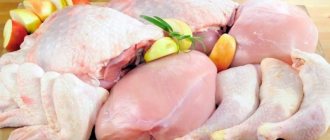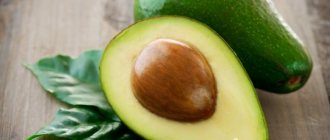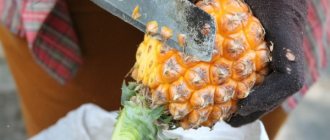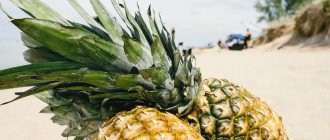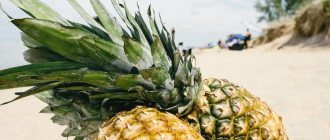Many people wonder how much and how to properly store pineapple at home so that it does not spoil. At room temperature, the shelf life of fresh fruit is short; you can store pineapple in the refrigerator longer. The storage temperature for pineapple varies depending on whether the fruit is ripe or not.
General recommendations
Pineapples are rather finicky fruits to store, since they arrive on store shelves unripe and often begin to rot and lose valuable properties even before they are fully ripe.
To enjoy the rich taste and aroma of the fruit and adopt its valuable properties, you need to pay attention to its proper storage.
To do this, you need to follow the recommendations:
- Temperature. The best temperature for storing pineapple is from 7 to 10 degrees Celsius.
- Humidity. Too low humidity in the room leads to drying out of the fruit, high humidity leads to its rotting. Keep it within 80-90%.
- Light. Artificial or natural light will inevitably cause the pineapple to ripen, so if you do not need this, choose dark places to store it.
- Leaves. When storing pineapple, it is not recommended to remove and cut the leaves from it, since without them it will only be stored for 1-2 days.
- Smells. When storing the fruit in cut form, place it in a container with a hermetically sealed lid, otherwise the fruit will quickly absorb surrounding odors from the refrigerator.
If you buy an initially unripe pineapple, you can generally keep it intact for up to two weeks if you choose the location and placement conditions carefully.
How to preserve pineapple until the New Year
By the way, there is an excellent selection of quick salads for the New Year.
In order to maximize the “life” of a pineapple after its purchase, we observe the following conditions for its preservation:
- Store at a temperature range of 7-8°C. Such indicators will ensure the freshness of the product without loss of taste and appearance. When the temperature is exceeded, the fruit begins to rot.
- To keep the fruit fresh for as long as possible, place it in a bag with holes or wrap it in paper or cotton fabric. We do not leave the “packaging” slightly open, since the fruit strongly absorbs the odors surrounding it.
- We maintain air humidity within 90%. Exceeding this indicator will lead to the formation of mold, loss of taste and wilting of the fruit.
Storing unripe pineapple
Since the exotic fruit does not grow in the CIS countries, it is picked and brought to us unripe and sold in stores as such, which is why difficulties often arise in storing the fruit.
Your task at this stage is to allow the pineapple to ripen and avoid premature spoilage of the unripe fruit.
To do this, follow the recommendations:
- Place the pineapple in a paper bag or parchment paper. If there are several of them, package the fruits in different bags.
- Store the fruit in a bright, warm place. You can simply leave it on the kitchen counter or even place it on the windowsill for faster ripening.
- The place should also be dry, otherwise high humidity may cause the fruit to rot.
- You can add other ripe fruits (apple, banana, pear) to the pineapple to speed up the ripening process.
At this stage, you should not store pineapple in the refrigerator, since low temperatures stop the ripening process of the fruit, which is why you will not achieve the desired result. However, it can deteriorate at this time.
Most often, if all recommendations are followed, 3-4 days are enough for the fruit to ripen. Check it daily for ripeness - once its leaves begin to come off easily, it is ready to eat.
About the benefits of pineapple
The benefits of fruits are due to their chemical composition. Pineapple pulp contains a large amount of substances beneficial to the body; it consists of 85% water, and 15% fructose, sucrose and glucose (monosaccharides). The composition contains malic, tartaric and citric acids; pineapple is rich in microelements:
- iron;
- manganese;
- magnesium;
- zinc;
- iodine;
- potassium;
- calcium.
Vitamins present in the fruit:
- beta-carotene;
- PP;
- E;
- A;
- C;
- B2;
- B12;
- B.
The composition contains fiber and enzymes of plant origin. The fruit is useful for people suffering from diseases of the musculoskeletal and cardiovascular systems. It is capable of thinning the blood, so it is often used as a prophylactic against thrombophlebitis and thrombosis.
The fruit relieves swelling, cleanses vascular walls of cholesterol plaques, reduces muscle and joint pain, and slows down the development of atherosclerosis. Due to its chemical composition, pineapple is used for pneumonia, pleurisy, sinusitis, sore throat, pyelonephritis and diseases of the gastrointestinal tract.
Storing ripe fruit
How to determine the ripeness of a pineapple
When the pineapple is completely ripe, it is not recommended to continue storing it at room temperature, since it will quickly begin to deteriorate and lose its rich taste and all its valuable properties.
At a temperature of about +20 degrees Celsius, ripe pineapple will be stored for up to two days. You can increase its shelf life by lowering the temperature; to do this, place it in the refrigerator, taking into account the following tips:
- There is no need to wash the fruit before putting it in the refrigerator.
- Place it in a paper bag, wrap it in parchment, or leave it in the refrigerator without additional packaging - using cling film and cellophane is not recommended.
- Store pineapple in the crisper drawer or on the top shelf of the refrigerator.
- You should not store the fruit in direct proximity to strong-smelling foods (for example, smoked fish), otherwise mixing of flavors cannot be avoided.
You can store a valuable product in this way for up to a week and a half, if it is not too ripe and begins to deteriorate. However, check it daily for ripeness so as not to miss the moment when the fruit begins to rot.
Additionally, it is recommended to turn the fruit over daily so that it lies or stands on different sides; this will also shift the load from one side and help avoid premature rotting of the fruit.
How to store unripe pineapple to ripen?
Even an unripe pineapple cannot be stored for too long, but there are ways to speed up its ripening:
- wrap in cling film, leave in a warm place and within a day the fruit is ready to eat;
- wrap in several layers of food paper, place next to other fruits, regularly replace damp leaves with dry ones, ripening period - 3 days;
- in the warm season, the pineapple can be taken out to the balcony, sprinkled with water and left for 5 days;
- during the heating season, the fruit can be wrapped in newspaper and left near the radiator;
- you can wrap the fruit in a terry towel or put it in a fabric bag and leave it in a dark, ventilated room;
- trim the foliage, leaving 2 cm, turn it over, so the pineapple will become sweeter, since the sugar will be evenly distributed throughout the fruit, but this will not happen earlier than in a week.
Advice! Regardless of the chosen method of storing unripe fruit, it must be regularly checked for ripeness. If you miss the moment, the fruit will become overripe and become unfit for consumption.
Storing cut pineapple
If you cut a pineapple, but did not finish it completely, you will also have to pay attention to its storage, since after removing the peel the fruit is usually stored for no longer than 2 days.
As soon as you realize that you have a chopped part of pineapple that you will not eat or use in cooking, immediately put it in the refrigerator to stop the natural ripening processes.
You can store cut pineapple in a glass container or plastic container with a hermetically sealed lid, which will help prevent foreign odors from penetrating the contents from the refrigerator. It is not recommended to use a regular plastic bag or cling film for these purposes, since they do not protect the product from the strong odors of other products.
It is recommended to eat pineapple within 24 hours; on the second day of such storage, it becomes suitable only for use in cooking, subject to additional heat treatment.
Which pineapple is suitable?
Only ripe, undamaged fruits can be used for storage. To determine how ripe a pineapple is, you need to evaluate its compliance with the following characteristics:
- Color. The unripe fruit has a greenish tint, while the fully ripe fruit has an even yellow color.
- The elasticity of the peel. When you press on the scales of a ripe pineapple, the peel quickly returns to its original state.
- Leaves. In an unripe fruit, they do not separate from the base; in a ripe fruit, they can be removed, but they still retain a rich green tint. An overripe one has yellow and dry leaves.
- Aroma. High-quality ripe fruit has a pronounced fruity smell; in overripe fruit it becomes too bright and sharp, and has almost no green aroma.
- Flesh color. In a ripe specimen it is rich yellow, uniform; the lower the degree of ripeness, the paler the shade of the pulp. Overripe and spoiled varieties are distinguished by a watery structure and spots of a darker shade.
When choosing a suitable specimen, you should carefully consider the scales of the peel; they should have the same shape, their area decreases in the direction from the central part to the crown and lower zone. There should be no damage, mold or rot on it.
Storing Canned Pineapple
If after the holiday you still have an open jar of canned pineapple, you can also preserve its contents if you close it tightly with a lid and place it in the refrigerator in time. Make sure that there are no strong-smelling foods in the refrigerator, the smell of which could spread to the preserved food.
It is recommended to leave the canned pineapple in the same solution in a store-bought jar. If you wish, you can pour its contents into a glass or plastic container with a hermetically sealed lid.
Canned pineapple can also be stored for 1-2 days.
Pineapple: is there any harm?
Despite its beneficial properties and composition, pineapple, like other exotic fruits, can be very harmful. Especially for nursing mothers and small children. First of all, this is an allergic reaction, which manifests itself in the form of skin itching, redness and various rashes.
In addition, swelling and difficulty breathing, increased excitability and sleep disturbances, upset stomach and changes in stool, pain and discomfort in the abdomen may be observed.
Pineapple, due to its high content of various acids, corrodes tooth enamel. Therefore, after eating this fruit, you need to rinse your mouth with clean water or a special mouthwash. It is better to drink pineapple juice through a straw.
The product contains many essential oils and organic fruit acids, which increases the acidity of the stomach and increases the risk of exacerbation of chronic diseases.
As we already mentioned, store-bought canned pineapple is not the best option. It includes increased amounts of citric acid and sugar, dangerous chemical additives and preservatives. Such products cause poisoning, allergies, digestive and dental problems, and provoke excess weight.
Pineapple should not be eaten if you have urolithiasis, diseases of the excretory system and digestion, with increased stomach acidity and colitis, with ulcers and gastritis, with arthritis, rheumatism and hypotension. It is prohibited for individual intolerance and diabetes, skin diseases and eczema. The product is not recommended for people with sensitive teeth or thin or damaged tooth enamel.
Freezing
Freezing is an effective way to preserve pineapple for a long time, which will avoid spoilage and preserve the taste and aroma of the fruit. The main part of the valuable properties of the fruit is lost as a result of such placement, but it is better to use this method than to let it deteriorate.
Freezing is performed as follows:
- Remove peel and leaves from the pineapple.
- Cut the fruit into rings or cubes, based on how it will be more convenient for you to store it and how you want to use it in the future.
- Drain excess juice from the fruit; you can use a colander for this.
- Place the fruit on a board lined with parchment paper and cover it with cellophane or parchment. Place the board in the freezer.
- After 6-8 hours, remove the board and transfer the fruit from it to plastic bags or plastic containers, sealing it tightly. Put them back in the freezer.
It is recommended to store pineapples in a compartment with berries, vegetables and other low-smelling foods so that frozen fruits do not take on their smell.
Freezing preserves pineapple for 3-4 months. When you need it, place it on the table at room temperature for several hours and use it in cooking. Pineapple is usually not consumed in its pure form after defrosting.
Useful properties of pineapple
After the question “how to store pineapple?” buyers are usually also interested in what beneficial properties its fruits have. This fruit is loved by all girls and women in the world who strive for an ideal weight. According to rumors, pineapple allows you to quickly break down fats and remove them from the body. Actually this is not true. Pineapple has the greatest effect on the breakdown of proteins and helps the body absorb them.
However, only the fresh product has these properties - you should not pay attention to medications that contain bromelain and are positioned as necessary for weight loss
In addition, this fruit has a fairly low calorie content and has less than 50 calories per 100 grams of food. This is another argument in favor of including it in the diet of women and men who are losing weight. However, you should be careful - pineapple is not recommended for people with stomach ulcers and gastritis. Otherwise, this sweet and juicy fruit is completely safe, even if consumed in excess, and can be used in recipes for completely different dishes.
Other ways to store fruit
Freezing is not the only way to store pineapple for a long time, which will help you save the valuable product from rotting.
There are two more methods often used by housewives:
| 1 | Conservation | More details |
| 2 | Making candied fruits | More details |
1
Conservation
In this case, the prepared pineapple is filled with sugar syrup and rolled into jars. Home-canned pineapples can be stored for up to 1-2 years before opening.
2
Making candied fruits
They are made with special dryers that evaporate all the moisture from the fruit, which is why they can be stored for up to a year.
You can use both methods when you have bought too much pineapple that you don't want to eat or use in cooking. In addition, they will help you enjoy the taste of your favorite fruit, even when it is almost impossible to find it in stores.
How to protect against mold and pineapple resuscitation
Mold is a common problem when storing tropical fruit. It is formed when each of the storage rules is not followed and under not entirely suitable conditions in which the exotic is stored. Often, mold is the result of non-compliance with storage temperatures and humidity in the room. Mold begins at a temperature of 12 °C for 4 or more days. Mold also forms at humidity levels well above 90%.
Compliance with each of the storage standards is not always the key to success in maintaining the original qualities of a tropical fruit. This is because a significant influence on the duration of storage without spoilage depends on the conditions of transportation from the place of growth to the store. When the exotic begins to deteriorate, it is possible to take the following measures:
- Peel and cut into rings.
- Remove each darkened area of pulp and wrap the slices in individual packaging from cling film and then put them in the refrigerator.
- When the “injuries” are minor, there is no need to clean them - you can cut out such places, wrap them in paper or cotton cloth and send them to the vegetable compartment.
- When you need to store it for a long time, you cannot keep the chopped fruit in the refrigerator - freezing or canning is required.
Pineapple is an exotic fruit native to the tropics, which cannot be stored fresh for a long time. But it is possible to maintain the original freshness for 2 weeks. When it is necessary to preserve the quality of an exotic product for a period of 2 weeks or more, freezing is required. But, if you follow each of the freezing rules, the quality of the pulp and taste are no different from fresh pineapple.
Storage errors
Even if you buy pineapples when they are in season and follow the storage instructions, the fruits can begin to spoil within a couple of days after you bring them home. This may be due to a number of storage errors.
The most common errors encountered are:
- Packing pineapple in cling film or plastic bag. In such packaging, the fruit begins to “suffocate” and rot after just a couple of days.
- Storing ripe fruit at room temperature. This way you can leave only unripe pineapple if you want to bring it to a ripe state.
- Storing the fruit on the lower shelves of the refrigerator. Since these shelves are located closer to the freezer, the temperature on them often drops to +2 - +5 degrees, which can lead to hypothermia of the fruit and its spoilage.
- Cutting leaves from pineapple after purchase. With them, the product begins to deteriorate much more slowly.
- Storing the fruit on one side. Even if you follow all the conditions for placing it, but do not turn it over at least once a day, over time it will begin to become softer and rot on this side.
Pay attention to common mistakes in order to comply with them and extend the shelf life of a valuable product, regardless of its stage of maturity.
Rules for choosing ripe pineapple when purchasing
Eating pineapple will help defeat cellulite, maintain breast elasticity, replenish the body with vitamins and forget about wrinkles on the skin. But only ripe fruit can do this, and choosing which one is an art.
Pineapples are harvested three times a year, but unlike bananas or mangoes, their fruits do not ripen after being cut. Green pineapple will remain tasteless no matter how much you keep it warm. The fruit will remain with burning lips and astringent pulp, which causes indigestion and stomach upset.
To ensure that your purchase does not disappoint, the main thing is to choose the right ripe fruit in the store. Simple instructions will help you cope with this task, following which it will be difficult to make mistakes. Before going to the checkout with the selected pineapple, it is evaluated according to the following parameters:
- Appearance.
- Weight and density of the peel.
- Condition of the sultan (upper shoots).
- Fruit aroma.
The first step is to evaluate the type of fresh fruit. You should choose a fruit with an oval shape and a dry stalk. The top shoots ideally have a length of 10-12 cm. They should not be dry or difficult to separate from the base, since in the first case this will be a sign of overripe fruit, and in the second of green fruit. The eyes are yellow-brown in color, their tips are dried out, and the grooves between them are brown or dark green. After you have selected a pineapple that is ripe and tasty in all external characteristics, you must pick it up to evaluate it by weight. A whole fruit weighs on average 1-2 kg; deviations in one direction or another may be signs of immaturity or drying out of an overripe fruit.
Be sure to press on the pineapple peel with your finger. On ripe fruit it is easily pressed and quickly restores its original position. If the peel is hard, like a coconut, the pineapple is green; if after pressing the dent remains, it is overripe and has begun to rot. It would be useful to tap the fruit as if it were a watermelon. A dull sound will indicate ripe fruit.
The upper green shoots can tell a lot about the ripeness of a fruit. An ideal fruit should have leaves that are green and juicy, yet easily separated from the fruit. Green leaves are difficult to separate from unripe fruit; brown leaves are a sign of spoiled fruit. You can also carefully try to twist the plume. If it gives in easily, you have a ripe pineapple in your hands.
Another sign of ripeness is the aroma of the fruit. You need to take the pineapple at arm's length and inhale its aroma. A ripe specimen will have a pleasant fruity aroma; the green one does not smell at all, but smells like rotten pineapple.
Video: how to choose a pineapple
How to choose a pineapple and peel it beautifully.
Watch this video on YouTube
Answers to popular questions
What if there are dark spots on the peel?
This sign is a natural indicator of spoilage of the pineapple, when detected, it becomes unfit for consumption.
How do you know if a pineapple is already ripe?
This can be easily determined by the tops - if you pull one leaf and it easily comes away from the fruit, it can be considered mature and suitable for consumption.
How long can you keep pineapple in the refrigerator?
If you put it there in an unripe state - up to 2-3 weeks, if ripe - up to 10-14 days.
Does the way you store pineapple affect its taste?
Certainly. If the pineapple is not completely ripe and you put it in the refrigerator, after cutting it will not be as juicy and tasty. This will also negatively affect its valuable properties.
Canned pineapple
If you want to stockpile the pulp of exotic fruits, you can preserve them. It is very simple, and the shelf life increases significantly - from six months to a year.
You only need 2 ingredients: pineapple and sugar.
Algorithm of actions:
- Remove the skins and cut the pineapple as you like;
- Place the pulp and sugar in a bowl or container without stirring, cover and refrigerate for 12 hours;
- After this time, you can notice that the pineapple has become juicier and the sugar crystals have dissolved;
- Place the mixture in a saucepan and bring to a boil over low heat, and then hold for a few more minutes;
- Sterilize the jars, put the pulp in them, fill it with syrup, close the lids;
- Roll up the jars and put them in storage.
Now you know exactly all the rules for storing pineapple at home. This means that this healthy and tasty fruit will be a frequent guest on your table both on weekdays and on holidays.
Can it be stored in the freezer?
Long-term storage methods include freezing. The cut fruit can be left in the freezer; the slices are placed in a plastic bag. Fruits are frozen in several ways, in the form of:
- puree;
- juice;
- whole pieces.
Before freezing, the fruit is washed several times under running water. Peel the pineapple, remove the top and bottom, and cut in half. The dense center can be removed with a sharp knife; ingrown scales can be removed using the same method. The fruit is cut into small flat slices so that they can be conveniently chopped and added to desserts, baked goods and salads.
After the fruit is frozen, it is easily separated from the cling film. The pieces should be placed in a bag, preferably with a zip fastener, and excess air should be released from it using a cocktail straw. It is recommended to label the package: the expiration date and contents are indicated on the label. It can be stored in the freezer for several months.
We recommend that you read Sage to stimulate pregnancy
To freeze pineapple puree, you need to peel the fruit, cut it into small bars and place them in a blender bowl. The pieces are crushed at high speed until pureed. It is frozen in glass jars, plastic glasses or ice cube trays.
If you plan to store the puree in a glass jar, it is recommended not to fill the container to the neck: the volume of the puree increases during freezing. The neck is tightened with polyethylene, hermetically sealed, or the puree is transferred to plastic containers, which are placed in the freezer.
Fresh pineapple juice is poured into molds and frozen. The storage principle is the same. During processing, the puree may change color: from pale yellow it will become bright orange, this will not affect the taste. If desired, you can preserve the color by first adding a few drops of lemon juice to the puree.
Home care
If you give a pineapple everything it loves - a lot of warmth and light - it will delight its owners with rapid growth, flowering and even fruiting. You can buy the plant at a flower shop or try to grow it yourself. In any case, your task is to provide the South American guest with appropriate conditions of detention.
Location and lighting
It is advisable to place a pot of pineapple on a south window. Let him enjoy the sunshine without restrictions. Unless on some too hot days you will have to shade it slightly. As a last resort, place the flowerpot on the southwest windowsill.
If you place it in another place, you will have to illuminate it with a phytolamp for up to 12 hours of daylight. The evergreen beauty will not be able to develop on artificial lighting alone. Still, he will need natural light, so as soon as you notice that your pet’s leaves have begun to turn pale, combine natural and artificial lighting. And don’t forget to rotate the tub from time to time so that the outlet receives light evenly.
Temperature
This heat-loving representative of the Bromeliad family will not forgive you for temperatures dropping below 16 degrees in winter. There is no need to specially take the pot out into the cool place. Pineapple will tolerate +20-22°C just fine. And in the summer, the warmer it is, the better. The ideal temperature is +25°C. But the plant will calmly survive the increase in degrees.
On particularly hot days, you can take the tub out onto the balcony or into the yard. Just choose a cozy place where the draft will not reach. And indoors, make sure that the cold wind from the window does not blow towards the leaves.
Watering
In winter, water the pineapple not very often, as the soil dries out. But when the bush is in a state of flowering or fruiting, moisture saturation should be increased. Soft and warm (30-35 degrees) water can be poured directly into the outlet.
Do not allow water to stagnate in the pot, otherwise the root system may rot, but the soil should be constantly moist. When September comes, gradually wean your green friend from frequent watering, preparing for the dormant season.
Air humidity
There should be a humid microclimate around the pineapple. During the warm season, constantly practice spraying the leaves. In winter this is not necessary. Unless the humidity in the room is too low. The pet tolerates showers well.
The soil
Select acidic and loose soil for pineapple. To get the optimal substrate, mix:
- 25% humus;
- 30% turf;
- 15% coarse sand;
- 30% crushed peat.
In such proportions the soil will be permeable.
Feeding and fertilizers
In the autumn-winter period, the green ward does not need feeding, as it is in a state of rest. And from spring to autumn you will have to feed it twice a month.
You can use complex fertilizers or alternate mineral fertilizing with organic fertilizing. It is recommended to use mullein from organic matter. Fill a liter jar one-third full with fertilizer, top up with water. Stir regularly, and after 10 days the solution is ready. Dilute it in a bucket of water and you can feed the pineapple.
When the plant loses color, use mineral complexes. When fruits appear, practice watering with sweet water (2 tablespoons of sugar per 20 ml of water).
Transfer
After bringing a pineapple sprout from the store, immediately begin replanting. To start, take a 3-liter pot. It should be wide enough and not too deep, since the roots are located close to the surface.
Line the bottom of the flowerpot with drainage, sprinkle with soil mixture or purchased soil for citrus fruits. Move the plant along with the earthen lump into a new container and add as much earth as needed. If you do everything correctly, the pineapple will respond with the appearance of young shoots.
Make the second transplant six months later, and the third one a year after the growing season. Next, watch the roots. As soon as they feel crowded, move the bush into a tub with a wider diameter. It is best to carry out the procedure in March. Each time during transplantation, deepen the root by 1-2 cm.
Trimming
The bush does not need any special pruning. Only dry or damaged leaves should be removed. At the same time, grab part of the healthy leaf adjacent to the sore spot. Disinfect the knife for work.
Flowering and fruiting
Usually 2-4 years after the rosette is formed, the pineapple produces a peduncle. If this does not happen, the plant can be “helped” to bloom. This is done in different ways:
- Feed with liquid organic matter throughout the growing season at intervals of 14 days;
- for 5-7 days, pour into the outlet a solution of 15 g of carbide diluted in 1 liter of water;
- cover the pineapple with a bag and place a piece of smoking carbide next to the flowerpot;
- Place overripe apples nearby on the windowsill and do not remove them for several days;
- fumigate with cigarette smoke once a week for 21 days.
After such procedures, in about 2-3 months an inflorescence should appear, and after a month the ovary should appear. After six months, you will be able to enjoy the ripe fruit.
Pineapple blooms with blue flowers. The process will take two weeks, accompanied by a pleasant aroma. Each of the flowers fades as the day passes. After the last one has faded, the fruit begins to form.
The ripening of the fruit marks the death of the plant. This doesn't happen right away. The pineapple still has time to produce young shoots that can be used for replanting.
Reproduction
Exotics can be propagated in three ways:
- seeds;
- apical cutting;
- daughter sockets.
All of them are effectively used at home with consistently positive results.
Seeds
You won't get seeds from pineapples bought at the supermarket. Therefore, you will have to buy them at a flower shop. Before planting, keep the seed for a day in a warm place, placing it between two wet wipes. The seeds should swell. Now they can be planted in a peat-sand mixture, planting 1-2 cm deep. Cover the top of the box with glass or stretch the film to create a greenhouse. Place in a warm place. In cool weather, the seeds may not hatch.
The first sprouts will have to wait from 3-4 weeks to 1.5 months. If the air temperature is above 30 degrees, germination will begin in the second or third week.
When rosettes with 4-5 leaves are formed, plant them together with a lump of earth in a regular soil mixture, adding a little crushed charcoal. Then grow them as mature plants.
Top
To do this, you need to buy ripe fruit in the store. Choose ones with firm green leaves. If they wilt or become lighter in color, the pineapple will not germinate. It is also impossible to get a new plant from frozen fruit, which is usually sold in winter.
Make sure the crust is an even golden brown color. Do not take green or stained ones.
When you get home, cut out the top (sultan) with a small amount of pulp. You can simply scroll the tops, disconnecting them from the base. Cut the lower leaves so that the stem is exposed by 2-3 cm. Treat the cut areas with a solution of potassium permanganate. Let the seedling dry for 2-3 days, keeping it hanging upside down. You can store it for up to a week, but no more.
Then plant it in wet sand, covering it with a cap cut from a plastic bottle. Keep the sprout in a warm place and moisten regularly. The roots should appear in about 3-4 weeks.
The second method of germination is in a glass of water. Just make sure that the leaves do not touch its level. Change the water from time to time.
When the roots reach 5-6 cm, they can be transplanted into the soil. The pot must be at least 15 cm in height. Cover the stem with roots with soil and leave the leaves outside. Keep the soil moist. The room should have enough light and warmth.
First, young leaves will appear in the rosette, and the old ones will gradually dry out and will have to be cut off. From now on, try to always have water in the formed funnel.
Basal rosettes
During transplantation, separate the formed children from the roots. They can be broken off or cut from a mature plant. It is desirable that these basal rosettes gain 15 cm in height and have a formed rosette with several leaves. Sprinkle the cut area with crushed coal. Place the children in a container with a sand-peat mixture, covering it with film.
How to grow pineapple at home from seeds: step-by-step instructions
Many people will naturally ask the question, where are the seeds of a pineapple if they are not in the pulp? In fact, the structure of this fruit is quite strange, so many scientists are still arguing and cannot decide what it really is: a fruit, a vegetable, or even a berry. In fact, the pineapple does have seeds, but not inside, as we are used to seeing. The pulp is actually just a substance to provide the seeds with nutrients, something like the yolk for the embryo.
Pineapple seeds
To grow pineapple from seeds, instructions:
The seeds are contained directly in these hard white scales, like pine cones. Inside they have small brown crescent-shaped seeds. To remove them, you need to peel off this skin with a knife and pick it out. After this, you need to throw these pieces of seeds onto a sieve and rinse under running water. It is necessary that the seeds are completely freed from the pulp. Next, carry out pre-treatment so that the plants take root as quickly as possible. To do this, prepare a weak solution of potassium permanganate, which prevents the development of bacterial and viral infections in the soil. It must be kept for 2 hours. After this, the seeds are listened to on a napkin or thick cloth. It is worth noting that it is now quite difficult to find pineapples in stores that contain seeds. The fact is that breeders have worked hard and varieties have appeared that do not contain seeds. Thanks to this, the pineapple pulp is very soft and tasty. Therefore, if you find a pineapple with seeds in the supermarket, know that it is a cheap variety.
After the manipulation, you need to start sowing the seeds. To do this, you need to pour some light substance into a small and not very deep container. Peat is suitable for these purposes. After this, the soil is loosened and slightly moistened
The grains are placed in it close to each other.
Please note that before planting the seeds, the soil is slightly compacted and slightly dried. It should not be dry or excessively wet, but slightly damp
After this, the seeds are sown and the top is covered with a 2 cm layer of soil. It is best if it is a deciduous tree. Using a sprayer, the soil surface is moistened and lightly compacted again. After this, you need to cover the pots or container with the seeds with glass or cling film. This is done in order to build a kind of greenhouse with high humidity. Thus, a kind of moisture cycle will occur inside from the film to the pot and back.
Pineapple seedlings
Now you need to be patient and keep the pot in good lighting conditions and fertilize the pineapple. From time to time it is necessary to remove the glass or film and allow air to penetrate directly into the pot. Just don't do it often.
Instructions on how to grow pineapple:
- When a fairly decent sprout with two leaves appears, you need to open the film more often and let fresh air inside.
- It is recommended to water the pineapple with complex fertilizers twice a month. After the sprout rises to a height of 5 cm, the film can be removed and transplanted into a larger pot, that is, dived.
- The basics of care are that the pineapple needs to be replanted, since its root system is quite developed and grows quickly. You must not allow very little space left in the pot and the culture to become cramped.
- It is worth noting that from a rosette it will actually be possible to grow a pineapple, including fruits, much earlier, while when grown from seeds, fruiting can only be expected after 7-8 years. From the outlet, the period is reduced, and the first fruits can be obtained in 2-5 years.
